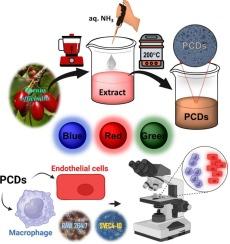环保合成多色碳点作为多色细胞成像的高效荧光探针
IF 5.1
3区 材料科学
Q2 MATERIALS SCIENCE, COATINGS & FILMS
引用次数: 0
摘要
以山茱萸果为天然碳源,以氨水为氮源和pH调节剂合成多色碳点(PCDs)。用各种分析工具系统地研究了水热合成的PCDs,以确定其结构和光学性质。通过XRD和拉曼光谱技术证实了所制备的PCDs具有一定程度的石墨化。利用FESEM、EDX、HRTEM、FTIR和XPS等技术对合成的生态友好型PCDs的结构形态和元素组成进行了表征。结果表明,合成的PCDs呈球状,平均直径为3.5 nm,具有丰富的表面功能基团,具有良好的分散性。当激发波长从低到高变化时,所获得的PCDs表现出多色发射。最大激发波长为~365 nm,最大发射波长为~441 nm,量子产率高达21%。PCDs表现出非凡的强度,在不同的生态(环境)条件下,以及暴露在紫外线下和长时间储存下,都能保持其荧光特性。此外,合成的PCDs具有良好的生物相容性,即使在高浓度下,也能在RAW 264.7(巨噬细胞)和SVEC4-10(内皮细胞)中保持95%以上的细胞活力。荧光成像证实了高效的细胞摄取和强多色发射,支持它们作为安全有效的活细胞成像探针的潜力。此外,在不同的激发光条件下,多色荧光、生物相容性的PCDs可以作为荧光团用于高效的多色细胞成像。它们可以进一步发展为药物递送的细胞靶向探针。本文章由计算机程序翻译,如有差异,请以英文原文为准。

Eco-friendly synthesis of polychromatic carbon dots as an efficient fluorescent probe for multicolor cell imaging
Polychromatic carbon dots (PCDs) were synthesized using Cornus officinalis fruits as natural sources of carbon and aqueous ammonia as sources of nitrogen, as well as a pH adjuster. Hydrothermally synthesized PCDs were systematically investigated by various analytical tools to determine their structural and optical properties. The resulting PCDs exhibited a modest degree of graphitization, which is demonstrated by XRD and Raman spectroscopy techniques. We employed FESEM with EDX, HRTEM, FTIR, and XPS techniques to characterize the structural morphology and elemental composition of the eco-friendly synthesized PCDs. These results reveal that the synthesized PCDs were nearly spherical in shape, with an average diameter of 3.5 nm, and were rich in surface functional moieties, exhibiting satisfactory dispersibility. The obtained PCDs exhibited polychromatic emission as the excitation wavelength varied from lower to higher values. The fluorescence wavelength of maximum excitation is ~365 nm, and the wavelength of maximum emission is ~441 nm, complemented by an impressive quantum yield of 21 %. PCDs exhibit extraordinary strength, retaining their fluorescence characteristics under different ecological (environmental) conditions, together with exposure to UV light and prolonged storage. Additionally, the synthesized PCDs exhibited excellent biocompatibility, maintaining over 95 % cell viability in RAW 264.7 (macrophage) and SVEC4-10 (endothelial) cells, even at high concentrations. Fluorescence imaging confirmed efficient cellular uptake and strong multicolor emission, supporting their potential as safe and effective probes for live-cell imaging. Moreover, polychromatic fluorescent, biocompatible PCDs can be used as fluorophores for efficient multicolor cell imaging under varying excitation light conditions. They can be further developed as cellular targeting probes for drug delivery.
求助全文
通过发布文献求助,成功后即可免费获取论文全文。
去求助
来源期刊

Diamond and Related Materials
工程技术-材料科学:综合
CiteScore
6.00
自引率
14.60%
发文量
702
审稿时长
2.1 months
期刊介绍:
DRM is a leading international journal that publishes new fundamental and applied research on all forms of diamond, the integration of diamond with other advanced materials and development of technologies exploiting diamond. The synthesis, characterization and processing of single crystal diamond, polycrystalline films, nanodiamond powders and heterostructures with other advanced materials are encouraged topics for technical and review articles. In addition to diamond, the journal publishes manuscripts on the synthesis, characterization and application of other related materials including diamond-like carbons, carbon nanotubes, graphene, and boron and carbon nitrides. Articles are sought on the chemical functionalization of diamond and related materials as well as their use in electrochemistry, energy storage and conversion, chemical and biological sensing, imaging, thermal management, photonic and quantum applications, electron emission and electronic devices.
The International Conference on Diamond and Carbon Materials has evolved into the largest and most well attended forum in the field of diamond, providing a forum to showcase the latest results in the science and technology of diamond and other carbon materials such as carbon nanotubes, graphene, and diamond-like carbon. Run annually in association with Diamond and Related Materials the conference provides junior and established researchers the opportunity to exchange the latest results ranging from fundamental physical and chemical concepts to applied research focusing on the next generation carbon-based devices.
 求助内容:
求助内容: 应助结果提醒方式:
应助结果提醒方式:


